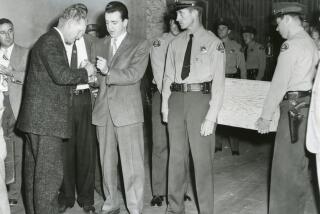Book review: ‘A Wild Surge of Guilty Passion’ by Ron Hansen
- Share via
On March 19, 1927, Ruth Snyder and her lover Henry Judd Gray murdered Ruth’s husband, Albert Edward Snyder, in his bed in Queens Village, New York. The murder plan was poorly conceived and badly carried out and in less than 24 hours the police had enough evidence to arrest Snyder and Gray. Whose plan was it? Who was the driving force in the murder? Who should get the death penalty? These questions remained for the trial that was held in the Queens County courtroom. It was one of the most publicized, highly attended, written and talked about events in a decade known for debauchery.
Prohibition, the Jazz Age, the financial surge before the Great Depression; in hindsight the frantic, desperate delusions of this period are evident. Alcohol and money (one hard to get, the other easy) made a mockery of American morality — marriage, sex, gambling in the stock market — everything seemed up for grabs. The story of the Snyder-Gray murder is irresistible for a storyteller like Ron Hansen, for whom context, period, culture is everything.
“A Wild Surge of Guilty Passion” is a gripping, entertaining novel. You can feel Hansen’s fascination with this story — and his delight at the wealth of material; the memoirs written by both murderers, the news and court reports, the testimony of lesser characters, the secondary material that flowed for years following the trial and execution of Ruth and Gray. The restraint is evident in his measured tone — this is fiction but the author still relies on the factual material — the times, dates, places.
What is most interesting to his readers, of course, is where he chooses to deviate from fact. In this, we are at his mercy, since how are we to know, really, when he takes liberties with the story, makes it his own? A truly successful novel based on historical fact would drag a reader to the same precipice of judgment, the same awe and horror that a citizen, say, of Queens Village might experience on waking to the paper on the morning of March 21 to see the headline, “Art Editor Slain,” or the headline a day later, “Wife Aids Killer.”
This of course, requires an enormous amount of restraint. Hansen has done prodigious research on the period details in the book — the dress, products, food, movies, books, favorite hangouts — which adds credibility but also color to the landscape, the playing field of the novel. Murder weapons, the background of the characters, motives are all also painstakingly researched. The author follows the trail of Ruth and Gray’s 21-month affair; the lives of Gray’s wife and 7-year-old daughter; the difficult home life of Ruth, Albert and their 9-year-old daughter. How could Hansen not form an opinion about who was the guiltier party? How could he not tumble headlong into the story, if not falling in love with the 32-year-old Ruth with the devastating figure and the velvety voice then hating her for her desperate manipulation of Gray, a man who, by most accounts, was putty in her hands?
It is clear from the beginning that Hansen has decided (as have most observers of the trial) that Ruth was, if not outright crazy, at least a sociopath. We know, from the moment in the fourth paragraph when Ruth says to her daughter, Lorraine, “Don’t untie me yet. Go over and get Mrs. Mulhauser,” that we are in the presence of someone diabolical.
Salter Reynolds is a Los Angeles writer.
More to Read
Sign up for our Book Club newsletter
Get the latest news, events and more from the Los Angeles Times Book Club, and help us get L.A. reading and talking.
You may occasionally receive promotional content from the Los Angeles Times.









